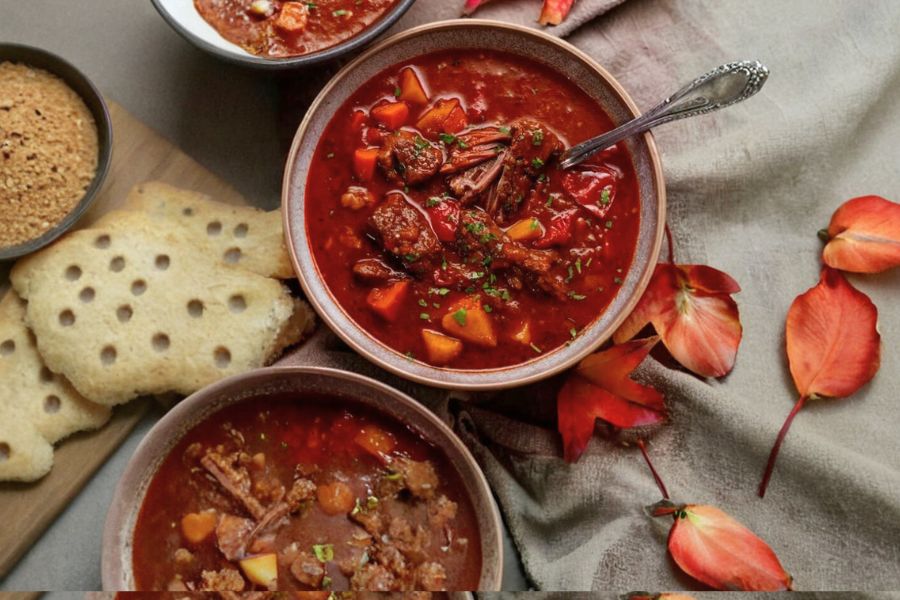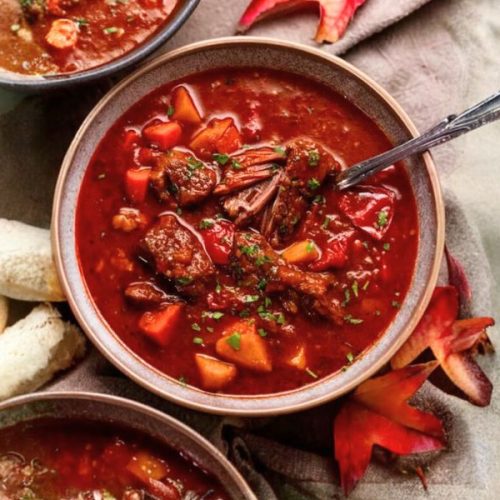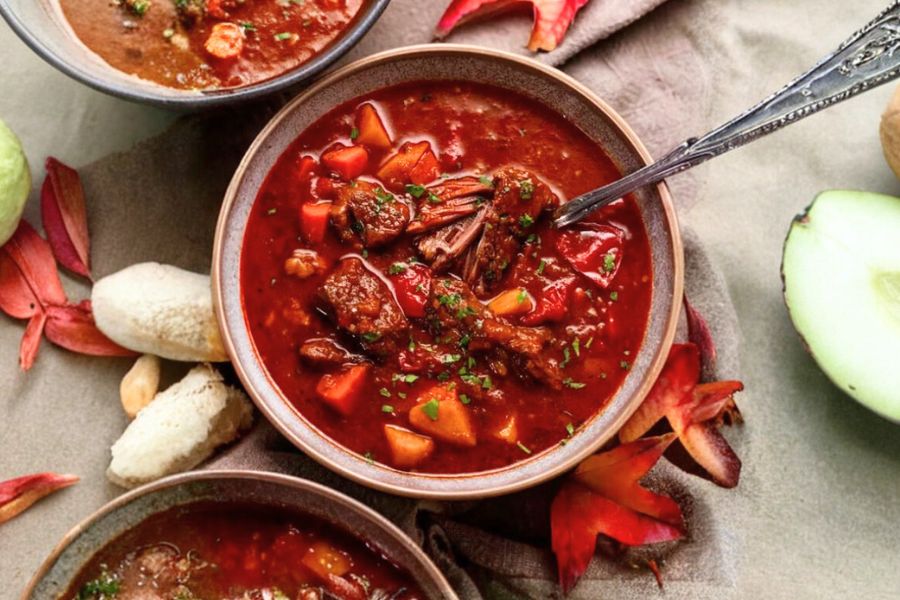This Hungarian Goulash is a timeless comfort dish that blends tender, slow-cooked beef with the warm, smoky sweetness of paprika and fresh vegetables, making it hearty and deeply flavorful.
It stands out for its rich, stew-like broth that’s naturally thickened with tomatoes, eliminating the need for heavy creams or flour-based thickeners.
Nutritionally, this recipe is a powerhouse—high in protein from the beef, loaded with fiber from carrots, potatoes, and bell peppers, and packed with immune-boosting vitamins A and C.
Despite its robust flavor, it’s a balanced meal with moderate carbs and nutrient-dense veggies, making it a satisfying, wholesome choice.

Its make-ahead friendly nature means flavors deepen overnight, making it perfect for batch cooking, family dinners, or cozy meal prep.
Must-Have Tools for Perfect Results
Lodge Cast Iron Dutch Oven
Essential for achieving deep, even heat for browning beef and slow-cooking to tender perfection. Doubles as a go-to pot for soups, stews, and bread baking.
OXO Good Grips Chef’s Knife
Perfect for efficiently cubing beef, chopping vegetables, and mincing garlic with precision. A long-lasting staple in any kitchen.
Cuisinart Wooden Spoon Set
Ideal for stirring onions, paprika, and broth without scratching cookware, offering comfort and control during long simmering sessions.
Hamilton Beach Slow Cooker
A hands-off alternative to oven cooking, allowing you to set and forget while still achieving melt-in-your-mouth beef for stews, curries, and roasts.
Meat Thermometer (ThermoPro Digital)
Ensures beef reaches safe, tender doneness every time, a reliable tool for all meats and roasts.

Nutritious Hungarian Goulash Stew
Equipment
- 1 Dutch Oven (large, oven-safe)
- 1 Chef’s Knife
- 1 Wooden Spoon
- 1 Slow Cooker (optional)
- 1 Meat Thermometer (optional)
Ingredients
- 1 kg 2 lbs beef chuck, cut into 1.5-inch (3.5 cm) cubes
- 1 ¾ teaspoons kosher salt divided
- 1 teaspoon freshly ground black pepper
- 1 tablespoon extra virgin olive oil
- 2 tablespoons 30 g unsalted butter
- 2 medium brown onions diced into small squares (about ½-inch pieces)
- 5 cloves garlic finely minced
- 2 bell peppers 1 red, 1 yellow, chopped into bite-sized chunks (approx. ¾-inch pieces)
- 2 fresh tomatoes sliced into wedges, then halved
- ¼ cup Hungarian sweet paprika or substitute mild paprika
- 1 teaspoon caraway seeds optional, for traditional flavor
- 1 bay leaf
- 4 cups 1 liter low-sodium beef stock or broth
- 2 carrots peeled, sliced lengthwise into quarters, then cut into small chunks
- 2 medium potatoes peeled and diced into ½-inch cubes
- 1 tablespoon fresh parsley finely chopped (optional garnish)
Instructions
- Prepare and Season the Beef: Pat the beef cubes dry with a paper towel to remove excess moisture, which helps them brown better. Toss the beef with half of the salt and all the black pepper, coating the pieces evenly. Set aside while you prepare the vegetables.
- Build a Flavorful Base: Heat olive oil and butter together in a large, heavy-bottomed Dutch oven over medium-high heat. Once hot, add the diced onions and sauté for about 6–7 minutes, stirring frequently, until they become soft and start to turn light golden around the edges. This creates the sweet, rich base flavor for the stew.
- Sear the Beef: Increase the heat slightly, then add the seasoned beef cubes to the pot. Stir for 2–3 minutes, just until the exterior turns from red to brown. You don’t need a deep crust; this step simply enhances the stew’s flavor.
- Add Vegetables and Aromatics: Mix in the minced garlic, chopped bell peppers, and tomato wedges. Cook for about 3–4 minutes, stirring occasionally, until the tomatoes begin to break down, releasing their natural juices to enrich the broth.
- Season with Spices: Sprinkle in the sweet paprika and optional caraway seeds, then drop in the bay leaf. Stir well for about 30 seconds, allowing the spices to bloom and release their aroma before adding any liquid.
- Simmer in the Oven: Pour in the beef stock and stir to combine. Bring the mixture to a gentle simmer, then cover the Dutch oven with a tight-fitting lid. Transfer it to a preheated oven at 350°F (180°C), or 320°F (160°C fan), and cook for 90 minutes. This slow, moist heat tenderizes the beef beautifully.
- Add Root Vegetables: After the first stage of cooking, check the beef—it should be soft but not yet falling apart. Stir in the diced carrots and potatoes, making sure they’re submerged in the broth. Cover and return to the oven for another 30–40 minutes, until the beef is fork-tender and the vegetables are cooked through.
- Finish and Serve: Remove the bay leaf and taste for seasoning, adding more salt or pepper if needed. Ladle the goulash into bowls, sprinkle with fresh parsley, and serve hot. Pair with crusty bread for dunking, or serve over buttered noodles for a heartier meal.
Notes
- Beef Cuts: Chuck roast is ideal for its marbling, which keeps the meat tender. You can also use boneless beef shank, beef cheeks, or brisket for similar results.
- Paprika Choice: Hungarian sweet paprika is traditional and gives a deep, slightly sweet flavor. Avoid hot paprika unless you want a spicier dish.
- Cooking Methods: While the oven is the easiest for even heat, you can cook on a stovetop over very low heat for about 2 hours (stirring occasionally), or use a slow cooker on low for 6 hours, adding potatoes and carrots in the last 2 hours.
- Make-Ahead Friendly: Goulash tastes even better after resting overnight in the fridge. The flavors meld beautifully, making it a perfect meal-prep dish.
- Storage: Store leftovers in airtight containers for up to 4–5 days in the fridge or freeze for up to 3 months. Reheat gently to keep the meat tender.
Chef’s Secrets for Flavorful Goulash
The secret to authentic Hungarian Goulash lies in patience and high-quality ingredients.
Choosing a well-marbled cut of beef, such as chuck, ensures that the meat turns tender and juicy during long cooking.
Hungarian-style sweet paprika is a must for that signature, rich flavor without overwhelming spiciness—avoid using hot paprika unless you prefer extra heat.
Browning the onions until lightly golden before adding the beef builds a flavorful base, while slow cooking allows the tomatoes to naturally thicken the broth.
For an even deeper taste, make the stew a day ahead—like most hearty dishes, Goulash tastes richer and more complex after resting overnight.
Serving Suggestions to Enhance Meal
Hungarian Goulash is traditionally served like a soup in a deep bowl, paired with crusty bread for soaking up the delicious broth.
Cheese bread or a warm baguette makes an irresistible companion.
For a more filling meal, serve over buttered egg noodles or fluffy mashed potatoes.
A crisp green salad or roasted seasonal vegetables balance the dish’s richness perfectly.
If you want a classic Hungarian touch, serve with a dollop of sour cream and fresh parsley for a creamy, tangy contrast to the bold paprika flavors.
Storage Tips for Freshness and Flavor
Goulash stores exceptionally well, making it perfect for meal prep.
Allow the stew to cool completely before transferring it to airtight containers. Refrigerate for up to 4–5 days, letting the flavors deepen each day.
For longer storage, freeze in portion-sized containers for up to 3 months.
Reheat slowly over medium-low heat on the stove, adding a splash of beef stock or water to loosen the broth if it thickens.
Avoid repeatedly reheating the same batch to maintain the beef’s tenderness and the vegetables’ texture.
Frequently Asked Questions about Goulash
1. Can I make this recipe in a slow cooker?
Yes! After sautéing the onions, beef, and spices on the stove, transfer everything to a slow cooker. Cook on low for 6 hours, then add the potatoes and carrots for the final 2 hours for the same tender results.
2. What can I use instead of Hungarian paprika?
If Hungarian-style paprika isn’t available, regular sweet paprika works, but you may miss out on some depth and smooth sweetness. Avoid smoked or hot paprika unless you want a different flavor profile.
3. Can I make Goulash ahead of time?
Absolutely! This dish tastes even better the next day as the flavors meld. Prepare it fully, cool, and store in the fridge. Reheat gently on the stove before serving.
4. How do I prevent the stew from being too watery?
The broth should be thinner than a typical stew but still flavorful. Allow it to simmer uncovered for 10–15 minutes before serving if you prefer a thicker consistency, or add a bit more tomato for natural thickening.
5. Can I substitute the beef with another protein?
While beef is traditional, you can use pork shoulder or even chicken thighs for a lighter version. Adjust cooking time since chicken will cook faster and may not require as long in the oven.
This recipe has been adapted and simplified from the original version by recipetineats. We’ve refined the steps for a smoother cooking experience and added helpful notes, nutrition insights, and essential kitchen tools to make it even easier for home cooks.

